In the geological timescale, the Tithonian is the latest age of the Late Jurassic Epoch and the uppermost stage of the Upper Jurassic Series. It spans the time between 149.2 ±0.7 Ma and 145.0 ± 4 Ma. It is preceded by the Kimmeridgian and followed by the Berriasian.
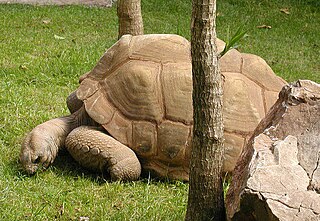
The Cryptodira are a suborder of Testudines that includes most living tortoises and turtles. Cryptodira differ from Pleurodira in that they lower their necks and pull the heads straight back into the shells, instead of folding their necks sideways along the body under the shells' marginals. They include among their species freshwater turtles, snapping turtles, tortoises, softshell turtles, and sea turtles.

Trionychia is a superfamily of turtles which encompasses the species that are commonly referred to as softshelled turtles as well as some others. The group contains two families, Carettochelyidae, which has only one living species, the pig-nosed turtle native to New Guinea and Northern Australia, and Trionychidae, the softshelled turtles, containing numerous species native to Asia, North America and Africa. These families likely diverged during the late Jurassic. The oldest known stem-trionychian is Sinaspideretes from the Late Jurassic of China.

The Pleurodira are one of the two living suborders of turtles, the other being the Cryptodira. The division between these two suborders represents a very deep evolutionary divide between two very different types of turtles. The physical differences between them, although anatomical and largely internal, are nonetheless significant, and the zoogeographic implications of them are substantial. The Pleurodira are known more commonly as the side-necked turtles and the name Pleurodira quite literally translates to side neck, whereas the Cryptodira are known as hidden-necked turtles. The Pleurodira turtles are currently restricted to freshwater habitats in the Southern Hemisphere, largely to Australia, South America, and Africa. Within the Pleurodira, three living families are represented: Chelidae, also known as the Austro-South American side-necked turtles, the Pelomedusidae, also known as the African mud terrapins, and the Podocnemididae, also known as the American side-neck river turtles. However, they were cosmopolitan clade during the Cretaceous and most of the Cenozoic, and even occurred in marine environments around the world.

Protostegidae is a family of extinct marine turtles that lived during the Cretaceous period. The family includes some of the largest sea turtles that ever existed. The largest, Archelon, had a head one metre (39 in) long. Like most sea turtles, they had flattened bodies and flippers for front appendages; protostegids had minimal shells like leatherback turtles of modern times.

Paracryptodira is an extinct group of reptiles in the clade Testudinata, known from the Jurassic to Paleogene of North America and Europe. Initially treated as a suborder sister to Cryptodira, they were then thought to be a very primitive lineage inside the Cryptodira according to the most common use of the latter taxon. They are now often regarded as late-diverging stem-turtles, lying outside the clade formed by Cryptodira and Pleurodira. The paracryptodires are said to have phylogenic relationships, noted as primary subclades, within the Baenidae and Pleurosternidae. Within each subclade, lies many biodiverse turtles that are continuously being investigated and added to the fossil record. Paracryptodires are divided into three main groups, Compsemydidae, known from the Late Jurassic to Paleocene of North America and Europe, Pleurosternidae, known from the Late Jurassic to Early Cretaceous of North America and Europe, and Baenidae, known from the Early Cretaceous to Eocene of North America. The latter two groups are more closely related to each other than to Compsemys, forming the clade Baenoidea.

Sinaspideretes is an extinct genus of turtle from the Late Jurassic of China, probably from the Shaximiao Formation. It is considered the earliest and most basal representative of the Trionychia, and is possibly the oldest known member of Cryptodira. In 2013, it was proposed that this animal and the genus Yehguia are in fact one and the same.

Bouliachelys is an extinct genus of sea turtle from Cretaceous Australia. It was originally described as a member of Protostegidae. In 2013 study it was considered to be a member of Dermochelyoidae, although later studies consider it as a protostegid again.

Pleurosternon is an extinct genus of freshwater pleurosternid turtle from the latest Jurassic to earliest Cretaceous of Europe. Its type species, P. bullockii was described by the paleontologist Richard Owen in 1853. Since then, and throughout the late 19th century, many fossil turtles were incorrectly assigned to this genus, though only two are currently considered valid.
Hispaniachelys is an extinct genus of thalassochelydian turtle known from the Lorente Formation of southern Spain. Reinterpretation of the original material shows that the taxon lacks diagnostic characteristics and is thus a nomen dubium.
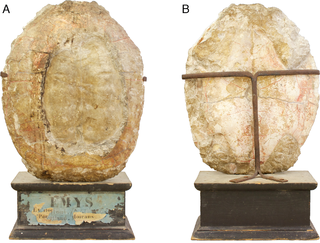
The Plesiochelyidae are an extinct family of turtles in the clade Thalassochelydia originally classified within the Cryptodira suborder, mostly belonging from the Jurassic period. An alternate study placed the clade Thalassochelydia in the Angolachelonia and outside the Testudines.

Macrobaenidae is an extinct family of turtles, known from the Early Cretaceous to Paleogene of Laurasia. Their relationships to other turtles and whether they form a monophlyletic group are controversial. They are typically interpreted as stem or crown group cryptodires, but some more recent analyses have found them to lie outside crown group Testudines. Macrobaenids can be distinguished from other testudinatans by the presence of a carotid fenestra, cruciform plastron with strap-like epiplastra, and a lack of extragulars.
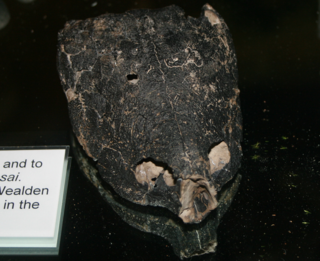
The Helochelydridae are an extinct family of stem-turtles known from fossils found in North America and Europe spanning the Early to Late Cretaceous.
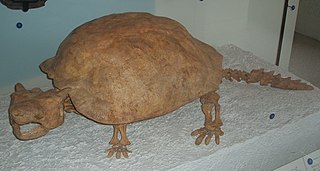
Perichelydia is a clade within Pantestudines known from the Middle Jurassic to Holocene. Alongside crown group Testudines, it also contains Helochelydridae, which is known from the Cretaceous of Europe and North America, Sichuanchelyidae from the Middle Jurassic to Paleocene of Asia and Europe, Meiolaniformes, which is known from the Cretaceous to Holocene of South America, Australia and Oceania, and Spoochelys, known from the Mid-Cretaceous Griman Creek Formation of Australia. Kallokibotion from the Late Cretaceous of Europe is also considered part of this group. Several other groups, including the proposed clade Angolachelonia, Paracryptodira, Macrobaenidae, Sinemydidae and Xinjiangchelyidae, which are sometimes considered members of Cryptodira, have also been found outside crown Testudines in several analyses. These groups are usually considered to be closer to the crown group than the other members of Perichelydia.
Euryaspis is a dubious genus of extinct thalassochelydian turtle from the Late Jurassic of Germany. The type and only species is Euryaspis radians, originally proposed by Wagner in 1859 before being validly described and illustrated in 1861. The only specimen was a partial carapace probably from the Tithonian, although the original locality is unknown. The genus is referred to Thalassochelydia and has been considered a synonym of Eurysternum or Acichelys before, but casts that remain of the lost holotype show that it bears no features that can clarify its validity making it a nomen dubium.
Owadowia is a genus of extinct thalassochelydian turtle from the Late Jurassic of Poland. The type and only species is Owadowia borsukbialynickae, named by Szczygielski and colleagues in 2017 for a partial lower jaw, coracoid, ilium and femur from the early Tithonian Kcynia Formation. The limited material means that it is difficult to compare Owadowia to its relatives, and it may not be a unique taxon. The genus lacks the features diagnostic to its parent clade Thalassochelydia, has similarities to Solnhofia and Portlandemys as well as being a Late Jurassic marine turtle like the remainder of the group.
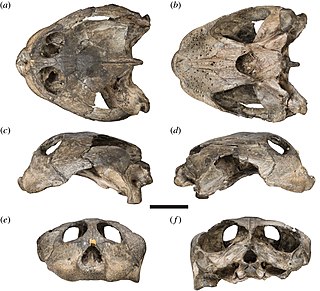
Sandownidae is a family of extinct marine turtles from the Cretaceous and Paleogene distributed around the Atlantic Ocean and adjacent areas. The family is defined as all taxa closer to the type genus Sandownia than to Pelomedusa, Testudo, Solnhofia, Eurysternum, Plesiochelys, Thalassemys or Protostega, a definition that encompasses the previous concept of the clade while also excluding it from being synonymous with other clades of modern or extinct marine turtles. Sandownidae may be within the larger clade Angolachelonia, defined as inclusive of Angolachelys and Solnhofia, sister to the entirely Late Jurassic marine group Thalassochelydia, although the concepts of the clades may shift with further phylogenetic analysis.
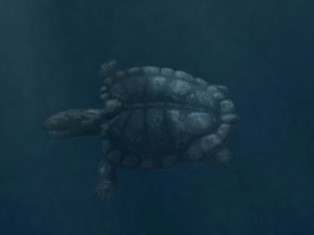
Angolachelonia is a clade of extinct turtles from the Late Jurassic to Paleogene of Eurasia. The group is defined as all taxa derived from the ancestor of the type genus Angolachelys and Solnhofia, a definition that could potentially encompass a clade of entirely marine turtles. Angolachelonia was originally inclusive of only Solnhofia, Angolachelys and Sandownia when originally conceived by Octavio Mateus and colleagues in 2009, but later phylogenetic analyses by Serjocha Evers and Roger Benson in 2018 unites the family Sandownidae, including Angolachelys and Sandownia among other taxa, with the entirely Late Jurassic clade Thalassochelydia, where Solnhofia may be a basal member. While the placement of Solnhofia is weak and the clade that Angolachelonia represents may change with further analysis, the clade of Sandownidae and Thalassochelydia is well-supported, and does not collapse despite the uncertain evolutionary history of the group. Three alternative potential origins of Angolachelonia sensu Evers and Benson are shown below.

Compsemydidae is an extinct family of turtles, likely belonging to the clade Paracryptodira. The earliest undisputed member is Tongemys from the Berriasian age of the Early Cretaceous; two Late Jurassic genera have also sometimes been included in the group, but may alternatively be members of the family Pleurosternidae. The genus Compsemys survived the Cretaceous–Paleogene extinction event and lasted until the Thanetian age of the Paleocene.
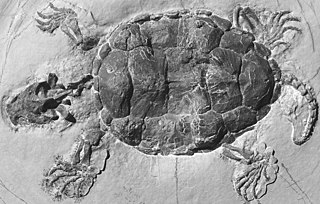
Platychelyidae is an extinct family of pan-pleurodiran turtles, known from the Late Jurassic and Early Cretaceous of Europe, South America, North America, and the Caribbean. It represents the oldest known clade of stem-pleurodires. All known members have been found in marine or coastal deposits. Despite this, their limb morphology suggests that they were not adapted for open marine conditions, but were likely inhabitants of shallow water environments, including brackish and saline waters, and they likely never inhabited environments more marine than lagoons. Their tolerance for saline environments likely aided their dispersal during the breakup of Pangea. Unlike modern pleurodires, which retract their necks to the sides, Platychelys retracted its neck inwards, similar to modern cryptodire turtles. Platychelys is strongly morphologically similar to mata mata and snapping turtles, suggesting that it had a similar ecology as a ram or suction feeder.



















